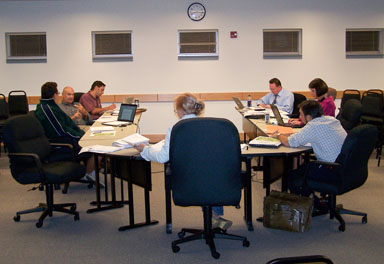September 8, 2010
Town Board starts exploring zoning
As they'd said they would, the Dryden Town Board took on the proposed local zoning law tonight. I'd misheard Supervisor Mary Ann Sumner's homework assignment - she didn't want to discuss setbacks tonight, but wanted to make sure board members had read the law up through setbacks to be ready to discuss the opening sections of the zoning.
I didn't hear any diabolical attempts to take away people's freedom tonight, or any rhetoric like what I'd seen at the informational meeting. The only other person from the public there was from the Ithaca Journal, and while I was very glad to see them there, this wasn't a meeting that really leant itself to exciting story-telling.

Town Attorney Mahlon Perkins talks about differences between local laws and ordinances with Dryden Town Board.
That is, unfortunately, kind of a problem. The board seems to be starting at the beginning of the law and working their way through to the end (though Attorney Perkins noted that the last thirty pages or so was existing law that didn't need repetition.) They did some good work in the definitions section, clarifying some definitions and hopefully reducing the pile of R-rated adult zoning definitions that aren't actually referenced elsewhere in the law. I think they got as far as building height before jumping out of the definitions section to areas that actually begin to apply those definitions.
The problem, as I see it, develops in two ways:
First, the proposed zoning law scatters bits and pieces of information around. The use table is great for figuring out at a glance what's allowed in a variety of zones, but there is no place in the document that brings together a description of the main zones with what uses are allowed them and features like the density and bulk tables. Figuring out the commercial (CC) zone means reading a definition on page 20, exploring the table on pages 22-26, following a column down page 27, and marveling at the density table on page 32. There's no single place that actually tells you what a commercial zone should be, and as Attorney Perkins put it, "I'm totally confused by this definition." (The overlay zones are better clustered and easier to understand.)
Second, editing the law section by section pretty much ensures that the conversation will follow the shape of the existing law, without much opportunity to step back and ask "is this what we really want?" There was a bit of discussion about a possible neighborhood residential zone that Environmental Planner Dan Kwasnowski had suggested, but breaking a new zone into the current document and conversation structure looks likely to be a challenge.
Yes, I'm picking on the commercial (CC) zone. Although a lot of people have expressed concerns about the conservation (CV) zone's impact, the CC zone is pretty much where the various competing elements of the zoning snarl together. It's a commercial zone that's also a dense residential zone when water and sewer are available. While this zoning is supposed to combat sprawl, the CC zone offers many opportunities to scatter it across and around the Town, mostly along already busy roads. As Perkins noted, it does some odd things like ban Bed-and-Breakfasts while allowing hotels and motels. Unfortunately, that tangled mess seems likely to be about our only option for shopping in the Town if it passes. (Okay, the hamlet zone will allow shopping and is almost as tangled, but at least folks in Varna got the Town to contemplate changing it.)
So what's to come? Dan Kwasnowski laid out a list of areas that need discussion:
Varna. This conversation is getting started back at the Planning Board, and Kwasnowski thought the plan put forward by the community should provide a workable start for addressing this quickly.
Large Scale Retail. There's an overlay district designed to allow this, but it's not on the map. Should it be? Should it be left off? Deleted entirely?
Site Plan Review and Special Use Permits. It sounds like informal opinion leads to the Planning Board handling projects that are just Site Plan Review and the Town Board handling anything that needs a Special Use Permit.
Density Tables. Pages 27, 31, and 32 have their controversial moments.
Overall organization. Some of this is the question of a local law as opposed to an ordinance, and the Town is leaning toward a local law. There's also content in here that duplicates material in other laws, and doesn't need repetition.
Use table. Apart from the details of what's allowed where, are pages 22-26 the best way to present the information?
Map. The map is always critical, usually the first thing readers turn to.
Some new concepts. Kwasnowski cited the frontage density formula as something he'd expected to hear more about but hadn't, and took the silence as a possible sign people don't understand it.
I also raised the question of accessory uses - some clarifying language would ease my concerns about accessory uses. The current draft isn't explicit enough about allowed secondary uses while being very explicit about prohibited uses that happen to be prohibitions only on primary uses.
Posted by simon at September 8, 2010 11:24 PM in planning and zoningNote on photos